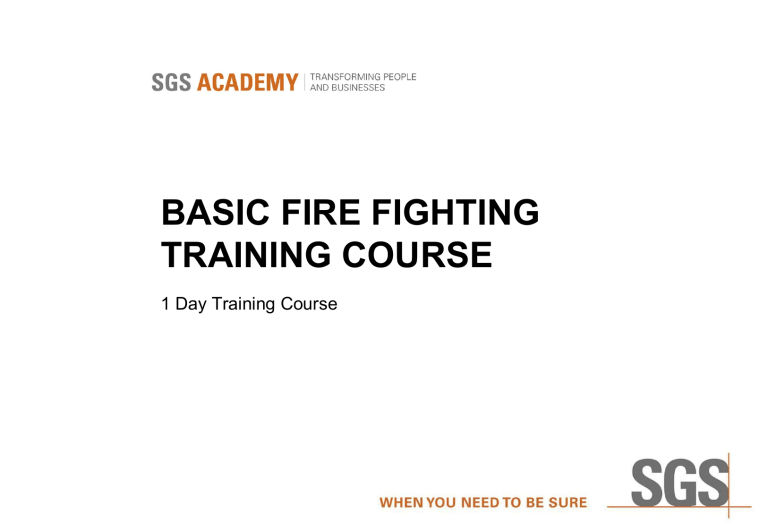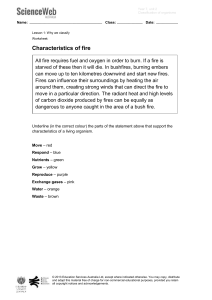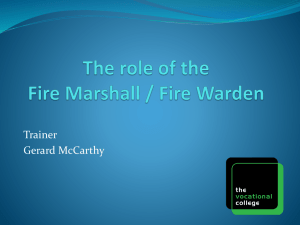
BASIC FIRE FIGHTING TRAINING COURSE 1 Day Training Course BASIC FIRE FIGHTING TRAINING COURSE Course Outcomes By the end of this Course, you will be able to: Have an Overview of Fire Prevent and Handle Fires in the Workplace Have an Overview of Fire Procedures 2 MANUAL STRUCTURE This Manual is structured as follows: Introduction Modules 3 SYMBOLS USED 4 COURSE TIMETABLE 09.00 Course registration 09.45 Course introduction Module 1: overview of fire Module 2: prevent and handle fires in the workplace 13.00 Lunch Module 3: overview of fire procedures Activity 1 15.30 Course summary 16.30 End of course There will be a break of 15 minutes mid-morning All course times are approximate 5 OVERVIEW OF FIRE MODULE 1 AGENDA Chemistry of Fire Classes of Fire Causes of Fire Spreading of Fires 7 CHEMISTRY OF FIRE 8 CHEMISTRY OF FIRE (CONTINUED) 9 CLASSES OF FIRE Class A Class B Class C Class D 10 CLASS A FIRES Fires involving ordinary solid combustible or fibrous materials, e.g.: Coal Paper Plastics Wood Textiles Rubber 11 CLASS B FIRES Fires involving flammable or combustible liquids and gases e.g.: Alcohols Benzene Oils Paraffin Petrol LPG Hydrogen Gasoline Kerosene Acetylene Paint and paint thinners Propane 12 CLASS C FIRES Fires of Class A, B or D type occurring in the presence of live electrical installations or equipment, e.g.: Electrical cables Generators Transformers Switchboards Distribution boards Panel boxes Power tools 13 CLASS D FIRES Fires involving metals e.g.: Aluminium Magnesium Sodium Potassium Lithium 14 CAUSES OF FIRES People Electricity Spontaneous combustion Chemical reaction LP Gas 15 SPREADING OF FIRES Fires can spread by means of: Convection: Natural flow of ventilation from a high to a low resistance Conduction: Through solid objects i.e. copper steel Radiation: Radiated from one object to another through the atmosphere i.e.: Heaters Air conditioners Fans 16 FUEL Fuel is present in three forms: Solids Liquids Gases 17 PROPERTIES OF COMMON FLAMMABLE LIQUIDS / GASSES Flash point Flammability range / explosive range Maximum explosion pressure Ignition temperature 18 OXYGEN Approximately 21 % oxygen is contained in the atmosphere People and fire need at least 16 % oxygen to thrive If oxygen level is reduced to below 16 % fires are extinguished Although oxygen does not burn, it lowers the ignition temperature of combustible materials that it contacts 19 HEAT Chemical heat Electrical heat Mechanical heat 20 END OF MODULE 1 QUESTIONS 21 OVERVIEW OF FIRE MODULE 2 AGENDA Prevent Fires through good Housekeeping Fire Prevention in relation to observing and adhering to Industry Safety Practices Fire Extinguishing Methods Operate Basic Fire Fighting Equipment Using the Correct Type of Fire Fighting Equipment Perform Basic Fire Fighting Procedures 23 GENERAL HOUSEKEEPING RULES Correct placement of fire extinguishing equipment Clearly visible – not lower than 1.5 m above ground or hidden by furniture / equipment Chevrons clearly visible No packaging material near electrical connections, distribution boards etc Location of equipment clearly marked Store cleaning equipment in spill proof containers 24 HOUSEKEEPING RULES (CONTINUED) Inspect fire hoses every 6 months by an approved provider Gauges should indicate a green marked if in working order Weight of fire extinguishers should be as per industry scale. 25 HOUSEKEEPING AND STORAGE CHECKLIST Are your premises kept clear of all kinds of refuse or process waste? Is waste swept up daily and removed from the building before closing? Are metal bins with lids provided for combustible waste? Are the waste collection areas safely located clear of building and stock? Do you control smoking in fire danger areas? Are the areas where smoking is prohibited clearly defined? 26 HOUSEKEEPING AND STORAGE CHECKLIST (CONTINUED) Are there adequate holders for discarded smoking materials in areas where smoking is not prohibited? Do you allow open flame fires or braziers in areas where combustible materials are used or stored? Do you know where on your premises employees group for breaks, luncheon or rest periods and are you satisfied with the fire precautions? Storage practices adequate? 27 CHECKLISTS Housekeeping Fire equipment Fire hazards – electrical Liquids and gasses 28 HOUSEKEEPING Are the premises clear of refuse or waste products? Is the waste removed accordingly? Are proper bins used for combustible waste? Are waste collection areas safe and located far from any buildings? Is the storage neat and packed effectively not to interfere with sprinklers? Has this report been handed to the correct authoritative person? 29 FIRE EQUIPMENT Are the extinguishers or hose reels in a safe proximity if needed quickly? Is the equipment serviced regularly e.g. seals? Is the equipment replaced after use? Has this report been handed to the correct authoritative person? 30 FIRE HAZARDS - ELECTRICAL Check extension wires which have been in the same position for a long period. Are electrical heaters safe and immovable? Are all installations switched off when not in use? Is all combustible stock clear from lights, heaters etc.? Do wall sockets have more than two plugs in them? 31 FIRE HAZARDS – ELECTRICAL (CONTINUED) Are electrical cables on dry surfaces and away from moisture? Are distribution and trip boards inspected? Has the electrician or engineer requested a specific inspection? Has this report been handed to the correct authoritative person? 32 LIQUIDS AND GASES Is there a list of all liquids and gases (used or stored)? Is all necessary stock kept in correct and approved areas? Are the liquids kept under strict supervision and control? Are correct precautions taken regarding storage and disposal of the products? Is there adequate ventilation at all times? Is a high standard kept in all areas where the products are used and stored? Has this report been handed to the correct authoritative person? 33 GENERAL INDUSTRY SAFETY PRACTICES Class A Fire Keep storage and working areas free of trash Place oily rags in covered containers Adhere to safety signs Adhere to smoking policy 34 GENERAL INDUSTRY SAFETY PRACTICES (CONTINUED) Class B Fire Do not refuel gasoline-powered equipment in a confined space, especially in the presence of an open flame such as a furnace or water heater Do not refuel gasoline-powered equipment when it is hot Keep flammable liquids stored in tightly closed, spill-proof containers. Pour from storage drums only what is needed Store flammable liquids away from spark – producing sources Use flammable liquids only in well-ventilated areas Adhere to safety signs Adhere to smoking policy 35 GENERAL INDUSTRY SAFETY PRACTICES (CONTINUED) Class C Fire Inspect for old wiring, worn insulation and broken electrical fittings Report any hazardous condition to the supervisor Prevent motors from overheating by keeping them clean and in good working order Utility lights should have a wire guard over to prevent the heat they emit from igniting ordinary combustibles Don’t install a fuse rated higher than specified for the circuit 36 GENERAL INDUSTRY SAFETY PRACTICES (CONTINUED) Class D Fire Store and use metals correctly 37 CONSEQUENCES OF NONADHERENCE TO SAFE PRACTICES Legal Financial Personal 38 FIRE EXTINGUISHING METHODS Removal of oxygen Smothering: Reduction of the oxygen content in the air around the flame to below 16% Methods: Application of carbon dioxide to the fire A foam blanket over the surface of burning flammable liquids Covering a pot of burning cooking oil with a lid 39 FIRE EXTINGUISHING METHODS (CONTINUED) Removal of fuel Starvation: When fuel is no longer available to the fire Methods: Removal of combustible material from the vicinity of the fire (back-burning during a grass or forest fire) Separation of the burning material from that not affected (pulling apart a thatched roof) Shutting off the gas supply to a gas flame 40 FIRE EXTINGUISHING METHODS (CONTINUED) Removal of heat Cooling: Reduction of the burning material’s temperature to below its ignition temperature Methods: Heat is absorbed by a cooling agent, usually water 41 FIRE EXTINGUISHING METHODS (CONTINUED) Method Lid placed on frying pan Carbon dioxide application Water application Burning firebreak ahead of forest or grass fire Removal of unburned material from fire vicinity Dry powder application Main Extinguishing Process Tetrahedron Element Involved Smothering Oxygen Smothering Oxygen Cooling Heat Starvation Fuel Starvation Fuel Quenching Chain reaction 42 FIRE EXTINGUISHING METHODS (CONTINUED) Tetrahedron of fire Scientists discovered a fourth component in the chemistry of fire – the chemical chain reaction. Combustion is a chain reaction and involved extremely active portions of molecules, which rapidly react and reproduce in the flame zone Quenching: Even if the three components of the fire triangle are present, a break in the chain reaction will extinguish the fire Methods: Halons produce chemical which block molecular reactions most dry powders decompose in heat and interrupt the chain reaction 43 IGNITION TEMPERATURE Ignition temperature is the lowest temperature at which a material is ignited, without the application of a flame and continues to burn after removal of the heat source 44 FLASH POINT The lowest temperature at which a liquid gives off sufficient flammable vapour in air to produce a momentary flash on the application of a small flame. Many flammable liquids give off vapours at room temperature – whether they do or not, depends on the liquid’s flash point 45 VAPOUR DENSITY Vapour density is a mass of a certain volume of a substance divided by the mass of the same volume (usually air) 46 EXPLOSIVE / FLAMMABILITY LIMITS Flammable gas or vapour will only burn in air if the fuel/air mixture lies within a certain range If too much, or too little fuel is present, burning will not take place; the mixture is either to lean or too rich The fuel/air ratio must be within a certain percentage range for the mixture to burn. This is known as the flammable range The lower flammable limit is the most important in determining the hazard Ventilation systems are design to prevent accumulations of vapours above the lower limit 47 OPERATING BASIC FIRE FIGHTING EQUIPMENT Fire extinguishers Label will indicate what type of fire (or a combination thereof) it can be used on Fire hoses 65 mm canvas hose connected to main water supply e.g. water hydrant which provide water over a distance to a certain point 48 OPERATING BASIC FIRE FIGHTING EQUIPMENT (CONTINUED) Hose reels 20 mm PVC hose that will be rolled up on a metal spool and connected to a water supply Fire blankets Asbestos blanket which is used to smother flames 49 OPERATING BASIC FIRE FIGHTING EQUIPMENT (CONTINUED) Chevron board Situated on base plate of the fire extinguisher. Yellow/red or re/white luminous board used to indicate where fire extinguisher is placed Fire extinguisher markers Luminous – indicate in which direction equipment can be located 50 USING THE CORRECT TYPE OF FIRE FIGHTING EQUIPMENT Class A For normal combustible materials such as wood, paper, plastics, etc. the agent to use is water or ABC dry powder Class B For flammable liquids and gases such as petrol, paraffin, oils, liquefied petroleum, Gas, acetylene, etc. the agent to use is ABC dry powder or foam and even carbon dioxide Class C For fires in the presence of live electrical equipment such as transformers, cables, motors, televisions, computers, etc. the agent to use is Carbon dioxide or ABC dry powder Class D For fires involving metals such as: aluminium, magnesium, sodium, potassium and lithium the agent to use is specified dry chemical powder 51 MARKING OF FIRE EXTINGUISHERS Class A and B fires Faceplate carry a numerical rating that indicates how large a fire an experienced person can safely put out with that extinguisher Class C fires Faceplate has a letter rating to indicate that the extinguishing agent will not conduct electrical current. Must also carry a Class A or B rating Class D fires Faceplate has a letter rating to indicate their effectiveness on certain amounts of specific metals 52 PERFORM BASIC FIRE FIGHTING PROCEDURES Take action on discovering a fire Precautions when fighting a fire Steps to take when containing fires 53 END OF MODULE 2 QUESTIONS 54 OVERVIEW OF FIRE PROCEDURES MODULE 3 RESPONSIBILITY FOR FORMULATING / MAINTAINING FIRE PROCEDURES The absence of a formal plan of action is often the cause of a fire developing into a major loss Every operating location must have an effective fire procedure Responsibility for formulating and maintaining effective fire procedures rests with the Fire Officer / Emergency Planning Committee The fire defence team includes: Fire team members / or wardens Fire team leader Fire officer etc 56 ESSENTIAL ASPECTS OF A FIRE PROCEDURES Mobilising the fire teams Calling the fire brigade Immediate attack by general employees Immediate attack by fire teams Liaison with fire brigade Evacuation – partial or total Salvage/recovery Post-emergency analysis 57 RAISING THE ALARM All premises must have a clearly laid down method whereby any employee discovering a fire can quickly alert: Members of the fire defence organisation, and Other employees in or about the area This method may be the activation of a manual fire alarm system or a verbal warning 58 CALLING THE FIRE BRIGADE There must be no delay in calling the Fire Brigade. It is better to call the fire brigade immediately than to risk serious spread of fire All persons charged with the responsibility of notifying the Fire Brigade must be trained in the correct procedure. The information required by the Fire Brigade is: Name and address of caller Address of premises involved Type of fire (vehicle, grass, buildings, etc.) Any additional information which may be of consequence to the brigade (e.g. lives in danger, people trapped, hazardous materials) Instructions must simultaneously be given to specified persons to meet the brigade at the appropriate entrance and direct them to the fire 59 IMMEDIATE ATTACK If no personal danger, attach fire immediately Person discovering the fire should try to contain and tell another to report it Having reported it, 2nd person should assist in putting out fire Fire team members should take over as soon as possible Take action to clear area from all persons If fire endanger the team, they should be withdrawn and Fire Brigade should take over 60 EVACUATION Where the need for evacuation is not immediately evident to all occupants the decision to evacuate should be the responsibility of the Emergency Controller or the person in charge at the scene of the fire Evacuation should be started as soon as it becomes apparent that fire or smoke may spread to other areas or floors, or there is a danger that escape routes may be affected. 61 STAFF TRAINING AND AWARENESS The training needs of all employees in fire procedure should include the following: What to do on discovering a fire How to activate the fire alarm How to use basic fire fighting equipment Awareness of the evacuation signal How to evacuate – primary and alternative routes to the assembly area Emergency shut-down procedures Securing of vital records, documents, cash – if there is time to do this safely 62 ACTIVITY 1 eplaces ISO 8402 Discussion of Fire Procedures 63 END OF MODULE 3 QUESTIONS END OF COURSE 64


